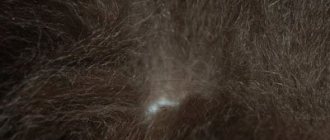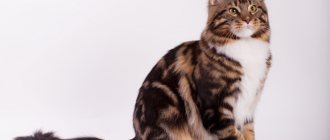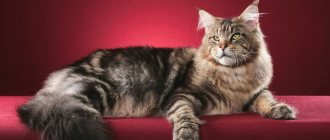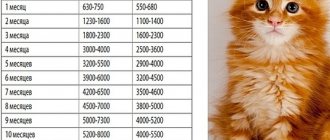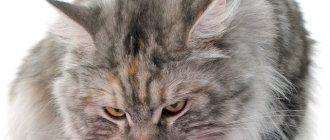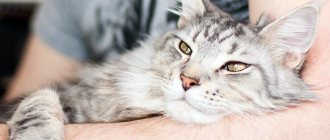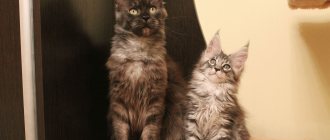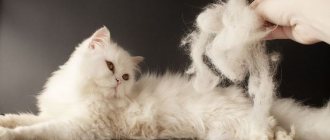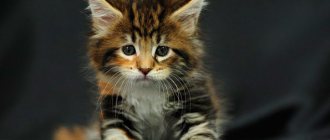Good day to all!
Let's talk about scallops? But not about these “tools” for caring for one’s appearance, which Nature has already endowed all the little ones with:
- the main one is the grater tongue;
- sometimes claws help out;
- those walking in the yard “by themselves” have kisul - “improvised means” in the form of tree trunks - to rub sideways and even grass - to lie on the back, i.e. easily throwing off the shedding tufts.
But domestic cats are “on their own” only during walks! And, since they live with us under the same roof, the point of hygiene in the “rules of life” for them is much more strict than for their yard, unfortunately homeless, brothers. In this matter, the owner comes to the aid of his furry cleanie.
Why are they?
Cat combs for combing fur were invented by man to keep a pet’s coat impeccably clean, beautiful and in order. And if a cat is taught from childhood to the procedure of combing (and also washing his eyes and cleaning his ears) with affection and play, then he will really love this care. And it will even ask itself!
But if you don’t teach it, then don’t be surprised. such a reaction:
This “brush” will “comb” anyone’s hair
Before the kitten appears in the house
You should carefully prepare for the arrival of a kitten in your home. It is necessary to hide the wires, remove household chemicals, poisonous plants and small objects that the kitten may accidentally swallow. If there are small children in the family, they need to be prepared in advance for the arrival of the pet so that the kids do not accidentally harm it. You should also purchase:
- bowls for food and water;
- feed;
- tray and filler;
- combs, shampoos;
- scratching post and nail clipper;
- carrying - a backpack;
- house or bed;
- toys.
All care and maintenance products should be purchased immediately based on an adult animal - Maine Coons do not like change.
How to train?
Very simple! For this:
- pre-bathe the kitten with shampoo (without conditioner), once it’s dry, sit it side by side - preferably on a litter, and while combing, communicate in a quiet and gentle voice - let it be pleasant;
- increase the time of toileting behind a fur coat gradually, avoiding the moment when the procedure ceases to be “a thrill”, so that he does not want to subsequently “beautify” with the help of the owner;
- choose the same time for care, forming an addiction to the daily routine; For those with a short coat, once a day is enough, and for those with a long coat, twice.
Any damage or inflammation of the skin is a contraindication for the procedure!
Types of scratchers and how to choose
We choose depending on:
- intended for: combing wool, undercoat, tangles or fleas; trimmer; grooming; massage; for thinning and shortening;
- fur lengths for: fluffy long-haired, smooth-haired, wire-haired or short-haired species;
- breeds for: British, Scottish and medium breeds;
- devices: with rotating or sharpened or very frequent teeth; glove; mitten; comb-rake; metal;
- from the manufacturer: for example, Keller, Artero.
Briefly about the main types
COMB - with teeth of different heights and frequencies (must have blunt tips!) - available for any length; needed for untangling matted wool and tangles; and the flea comb has very frequent teeth.
A comb with rotating teeth is more effective than a simple one. But don't use it for
very long fur, because hairs can get wrapped up and be pulled out by the roots!
Slicker (slicker) is a “cruel” tool that tears out the undercoat! It is only used to raise the pile on the “pants”, “collar” and tail. Not for tangles and not for combing! But only for healthy and first combed wool with a sparse comb, and no more than twice a week during molting and once after it ends, and daily - it’s impossible!
The length of the teeth is more frequent and longer, the thicker the undercoat and the longer the guard hair. Not for short-haired people!
FURMINATOR is a favorite of cats and... a “jack of all trades”, because it combines: a simple comb, a comb for trimming (for manually removing undercoat), and a slicker brush; Available for different lengths of pile.
Operating principle: the fluff clings to the notches on the comb teeth and is brought out, while the guard hair does not cling and remains in place.
The undercoat is formed from 2-3 additional downy hairs growing from the same follicle as the guard hair. During molting, they die and fall out, and new ones grow in their place. The Furminator extracts dead and no longer needed fur “perfectly”!
Rules for walking a pet
Maine Coons love to walk outside and such walks are important for their health, but they can only be walked with a harness.
The harness is a figure-of-eight harness; it is convenient because, unlike a collar, it does not choke the pet and does not allow him to jump out of it.
It is necessary to choose a light, non-metal harness, which at first the pet should wear in the house and without a leash in order to get used to it.
After a few days, you need to attach a leash with a maximum length of 4 m to the harness and allow the cat to get used to it while walking the pet around the apartment. For walks on the street, you should choose a quiet place away from the roadway. You should not scold your coon if he refuses to go forward; walking on a leash should only be encouraged.
For short-haired representatives
Plush and thick wool, for example, the British shed heavily, for care you need:
- metal comb with frequent thick teeth;
- at the end of the procedure, use a natural brush (or rubber mitten).
- comb-comb;
- a brush with sparsely spaced bristles.
Bengal, toyger, ocicat should be combed 2-3 times a week, in the “arsenal”:
- metal comb with densely spaced thick teeth;
- then the mitten;
- At the end, wipe with a piece of suede for shine.
And here the powder is harmful!
And further…
But what should your animal do if he can never, ever go for a walk?
And you... replace his tree trunks and grass - natural “self-groomers” - with homemade or purchased models:
Read about them in our article “There are different types of scratchers for cats.” Good luck to everyone!
Maine Coons need regular coat care: bathing and constant brushing will prevent the appearance of hated tangles and make the coat smooth and silky. The animal's fur reaches its greatest length on the neck, tail, scruff and hind legs.
Maine Coon owners should choose the right brushes and combs for combing, shampoos and grooming devices - this will help maintain not only the beautiful appearance, but also the health of their pet.
Active lifestyle
Despite their enormous size, raising Maine Coons is possible. They are very active animals and will not spend time lying on the couch. They are constantly on the move, love active games, and are very sociable.
If you constantly work with them and educate them from an early age, you can achieve good results. Training a Maine Coon is quite possible. They learn some dog commands:
- respond to the call and always come running when you hear the nickname;
- can execute the “fetch” command and give a toy;
- master the “sit” command.
But when the mane is not busy with games and communication, he can act up, break a vase, drop an indoor flower from the windowsill and do a lot of mischief.
Accessories for Maine Coon
The peculiarities are that Maine Coons have retained their hunting instincts, they are constantly on the move, love to play, and cannot lie still for a long time. For them you need to immediately select a set of accessories. Otherwise, he will turn any thing he likes into a toy. The industry has developed a lot of useful things and toys for the cat fraternity, such as:
- Scratching posts of different shapes and types;
- Play complexes with several houses and multi-level playgrounds;
- Separate houses, hanging hammocks and soft beds;
- A variety of soft, winding toys, balls and intricate tunnels.
Maine Coon Shedding
Shedding in the Maine Coon breed can occur both due to health problems and as a result of natural factors.
Interesting! Shedding is periodic, since each hair lives on average for about a month. If you do not brush your Maine Coon, the dead hair will not be removed, which will cause the coat to become matted.
Seasonal
Maine Coons living in apartments are not affected by sudden changes in temperature, so their shedding is no longer seasonal. Most often it occurs in mid-spring or summer, but due to poor ventilation of the room or unbalanced nutrition, this process can begin at other times.
Age
Maine Coon grooming should begin from childhood, since the pet sheds as it grows.
At the age of six months to a year, the kitten's fur becomes thicker and coarser - at this time, active loss of the baby's undercoat occurs, and the Maine Coon needs to be scratched with a comb or comb at least once a week.
Important! Accustoming your Maine Coon to combing should begin early and gradually, otherwise in the future this procedure will cause aggression in the animal or cause prolonged stress.
Age-related molting can last up to two years - at this time, the body, due to restructuring, needs a large amount of vitamins and beneficial microelements. A deficiency of these substances can cause severe hair loss and deterioration in its appearance.
Vaccinations
The first vaccination is given when the kitten is 2 months old. A complex vaccine is used that protects against rhinotracheitis, panleukopenia, calicivirus infection and chlamydia. The second vaccination is given at 3 months, and at the same time the pet is vaccinated against rabies. Subsequently, vaccination is carried out at 1 year of age and annually thereafter.
10 - 14 days before vaccination it is necessary to carry out deworming.
Care during shedding
The shedding period can last from 25 to 45 months - during this time it is necessary to regularly use a high-quality brush to care for your Maine Coon. If you ignore brushing, the animal may eat the hair. This will negatively affect the functioning of the gastrointestinal tract.
Interesting! Males shed more heavily than male cats.
In addition to using a comb, bathing and blow-drying, as well as introducing vitamins into the diet, will help ease the shedding process.
Toys
All toys for Maine Coons can be divided into several categories:
- balls, mice and other toys that the cat rolls on the floor - it is important that they do not contain small parts;
- so-called teasers - the cat can play with them only in the presence of the owner, since they have feathers or small balls that the coon can tear off and swallow;
- Interactive is the best option for Coons, promoting their development and helping them tolerate loneliness more easily.
It is important to choose high-quality toys that do not contain toxic substances.
How to care for Maine Coon fur
Everyday care for your pet's coat includes several steps that require little time and minimal preparation.
Combing
To brush your cat you will need 2 combs:
- with sparse, long teeth will easily remove tangled hairballs;
- with frequent but shorter teeth will remove the remains of fallen hair and dirt.
Combing is carried out from the back of the head towards the tail.
You should not buy:
- furminator, designed for grooming dogs;
- slicker, as it can cause microtrauma and severe pain to the pet.
It is also allowed to use rotating comb brushes with rounded metal teeth to care for a cat's fur: they are well suited for combing very long hair that is prone to tangles.
During non-shedding periods, it is recommended to use the comb twice a week.
Bathing and cosmetics
When swimming, you should adhere to a number of rules:
- heat the water to 38 degrees;
- protect the bathroom from drafts;
- Place a small towel at the bottom of the bath and constantly stroke your pet - this will reduce stress levels;
- Do not allow water to get into the cat’s ears and eyes.
You should bathe your pet during shedding, to facilitate it, and during the recovery period after diseases that did not allow the animal to fully care for its coat on its own.
During bathing, special shampoos for long-haired pets are used. Finally, the fur coat is rinsed with good pressure of warm water in the direction of hair growth.
The washed pet should be carefully dried with a soft towel - active friction can greatly tangle the wet fur. If the animal is in the period of molting, it should be dried with a hairdryer; in other cases, the cat should be allowed to lick itself. And only after that you can comb the Maine Coon with a comb.
Fighting tangles
It is not recommended to untangle the tangles found by hand or with a comb; they must be carefully cut out with nail scissors. Most often, the hair gets very tangled in the tail, belly, neck and hind legs.
The main cause of tangles is a skin fungus, which is easily identified by the presence of dandruff. In such a case, it is necessary to visit a veterinary clinic so that a specialist can prescribe antifungal therapy. To prevent the appearance of tangles, it is recommended not to forget about regular use of a comb.
Poor nutrition, lack of hygiene and deteriorating health primarily affect the condition of the animal's coat: it becomes brittle, loses its shine and falls out. To avoid negative consequences, you should carefully monitor your pet’s diet, do not neglect the described rules of care, and conduct preventive examinations with a veterinarian.
Toilet and tray training
It is necessary to monitor the pet and its behavior.
If he moves restlessly, tries to find a secluded place, meows, then these may be signs that the cat wants to go to the toilet.
You need to carefully pick up the coon, take him to the tray and put him in it, not allowing him to leave until he goes to the toilet. You should also take your pet to the toilet after sleeping and eating. It is necessary to ensure that the tray is clean - strong unpleasant odors repel animals.
During the first month, you can limit the pet’s space, leaving him with a minimum of opportunities to relieve himself in the wrong place. If a puddle is still noticed outside the tray, you should blot it with a napkin, which should then be placed in the tray - this smell will attract the cat and indicate to him the correct place for the toilet.
You cannot scold or physically punish a cat - this will only scare it away.
Types of combs for cats
Tools for caring for a cat can be divided into combs, brushes and other devices, which include furminators and tangle cutters.
Combs or combs
- Combs with rare and frequent teeth. Necessary for primary combing of wool. Sometimes both types are combined in one device;
- Flea comb. It is distinguished by very frequent teeth and is intended for the care of paws and muzzle, where the hairs are short;
- Comb with teeth of different levels. Used for combing cats with long hair and semi-long hair with a thick undercoat;
- Rake comb. Allows you to carefully care for the fur without causing discomfort to the animal.
Brushes
- With metal teeth. Necessary for combing areas with long and rich hair (collar, fluffy pants), carefully unraveling tangles;
- With natural bristles. Helps when using dry shampoo or powder - applies, distributes and eliminates residue. Also intended for massage;
- Silicone glove or brush with hand attachment. Needed to remove dead hair and massage the skin;
- Slicker, or slicker. It has thin, slightly curved metal teeth. Used for styling tails and fine coats, as well as correcting the condition of the undercoat.
Other tools
- Colt cutter. A metal device with serrated blades. Allows you to carefully remove tangles that cannot be combed;
- Furminator. With its help, dead hairs of the undercoat and awns are combed out. Not intended for cats that regularly participate in exhibitions.
Scratching posts
A scratching post is necessary not only to protect furniture from damage, but also to maintain the health of your pet. Too long nails can cause curled nails, discomfort when walking and, as a result, lameness, sprained ligaments, painful cracks and chipped nails. Scratching posts can be:
- wall - planks covered with sisal rope or canvas;
- floor - sisal rugs lying on the floor;
- free-standing - posts wrapped in sisal rope and standing on a wide, round base.
It is believed that wall-mounted scratching posts and posts are better for coons.
How to train?
After the cat wakes up, you need to pick him up and take him to the scratching post. First, he should sniff it and calm down, then, supporting the pet, you should run the pads of his paws along the scratching post. This needs to be repeated several times, then praise and pet the pet.
How to choose a comb for a cat?
The set of equipment for grooming depends on the breed of the cat and its coat. The brushes required for a smooth-haired cat may not be suitable for long-haired animals. They will also likely require additional tools.
Combs for long-haired cats
The most striking example of a cat with long hair is the aristocratic Persian. Their rich coat and long hair require frequent and careful grooming. Despite the fact that the coat looks very fluffy, it feels like down to the touch. All hairs are very thin and prone to matting, and the undercoat is completely absent.
To comb Persians you need:
- Combs with teeth of different lengths and frequencies. The use of these tools is the basis of grooming, and it is with them that you should comb your pet;
- Brush with natural bristles. Designed to give the coat an ideal look and remove missing hairs.
The slicker is completely unsuitable for caring for this breed - it injures the skin, tears out fine hair, causes pain and disrupts the hair structure.
Combs for short-haired cats
The plush and loose-fitting coat of the British and Scots requires a completely different approach. They have a well-developed undercoat, equal in length to the guard hair. Despite the fact that these breeds are short-haired, their coat is thick, and the Scots and British are highly susceptible to shedding.
To care for these breeds you need:
- Metal comb with medium-frequency teeth. It is with this that you need to start combing your pet;
- The second stage is a slicker to care for the undercoat and remove excess hairs;
- The procedure is completed with the help of a massage brush, which gently massages the animal’s body and smoothes the fur.
Cats are proud and capricious creatures. Not everyone can easily tolerate manipulation of wool, especially if it has become matted. Royal Groom products for cats simplify the combing process and remove the electrified effect. Regular use of sprays prevents tangles and has a moisturizing effect.

